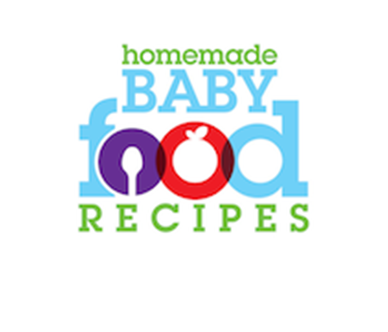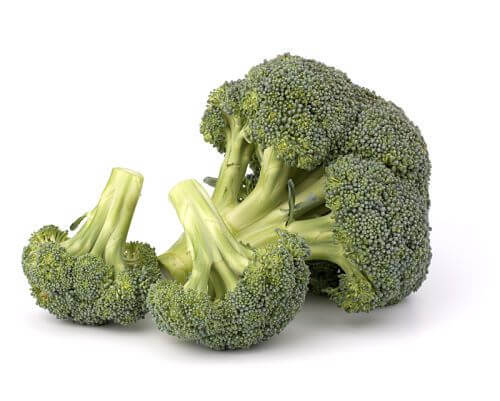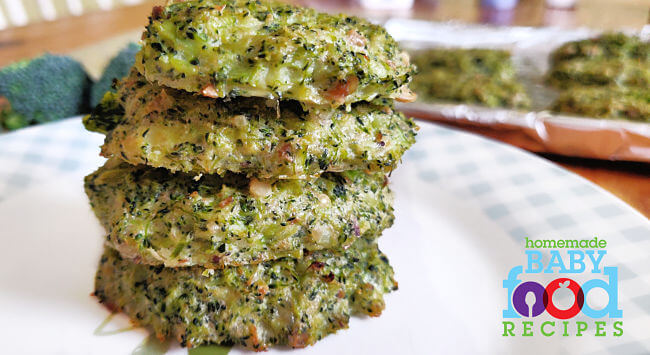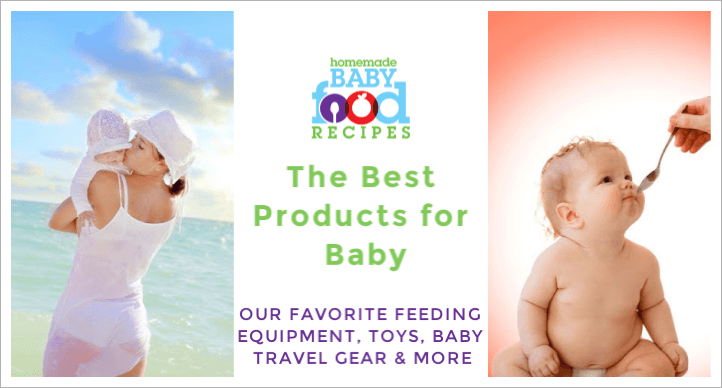Broccoli Baby Food Recipes
Updated: Sept 14, 2023
These broccoli baby food recipes and guidelines for introducing broccoli show you how and when to include this superfood in your baby’s diet.
Please note: When you introduce any new foods to your baby, it is important to follow the four day rule, to help you spot potential food allergies and digestive problems.
Please remember to consult your doctor before including new foods in your baby’s diet.
Broccoli Facts
Broccoli – it has the reputation of being the veggie that children love to hate!
US ex-president George H.W.Bush has even weighed in on the broccoli bashing, declaring back in 1990
“I do not like broccoli.
And I haven’t liked it since I was a little kid and my mother made me eat it.
And I’m President of the United States and I’m not going to eat any more broccoli.“
So you might be forgiven for thinking that getting your baby to enjoy broccoli is going to be difficult – particularly if you’ve been put off broccoli by your own childhood memories of a rather watery, overcooked vegetable with an unfortunate tendency to cause gas!
Yes, it’s a sad fact that previous generations had the strange habit of cooking vegetables to death, which has given many of us rather skewed ideas of what those vegetables actually taste like!
So this page looks at just how to serve DELICIOUS broccoli to your baby (yes, really!) and explains why broccoli richly deserves its ‘superfood’ status!
Why broccoli is so good for your baby
Broccoli is a cruciferous vegetable, related to other veggies like cabbage and Brussels Sprouts. It is simply dripping with nutrients, including
- vitamin C
- vitamin K
- vitamin A (from beta-carotene)
- B vitamins
- fibre
- calcium
- iron
- folate (folic acid)
- omega 3 fatty acids
- selenium
- zinc
- protein
Impressed?
You should be, because in addition to the nutrients listed above, broccoli is also packed with phytonutrients, one of which – sulforaphane – is a powerful, natural weapon against cancer.
There are many studies to indicate that a diet rich in broccoli can help protect the body against cancer AND support both heart and stomach health.
The further benefits of broccoli to your baby’s body are enormous…
The iron and calcium it provides – both of which are vital to healthy infant development – are made even more accessible to your baby’s body thanks to the broccoli’s high vitamin C content.
This is because vitamin C helps the body absorb calcium and iron very effectively (which is why medical professionals advise consuming fruit with every meal).
What’s more, broccoli can really help boost your baby’s immune system and has anti-inflammatory properties.
This means it may help reduce the severity of certain allergic reactions and conditions like asthma.
As you can see, broccoli is a ‘superfood’ in more ways than one – and don’t forget that its high folate content makes it a ‘must eat’ vegetable if you’re expecting another little one.
Folates have been shown to significantly reduce the risk of the unborn baby developing birth defects during pregnancy.
When can my baby eat broccoli?
You may have heard that you should avoid making broccoli baby food at home because broccoli is high in naturally occurring nitrates.
However, the American Academy of Pediatrics states in its article Infant Methemoglobinemia: The Role of Dietary Nitrate in Food and Water that
“Infants fed commercially prepared infant foods generally are not at risk of nitrate poisoning.
However, home-prepared infant foods from vegetables (eg, spinach, beets, green beans, squash, carrots) should be avoided until infants are 3 months or older, although there is no nutritional indication to add complementary foods to the diet of the healthy term infant before 4 to 6 months of age.“
Some parents still prefer to wait until their babies are around 8 months of age before offering broccoli.
You should – of course – speak to your doctor before using broccoli in YOUR baby food recipes.
However, we have introduced it to our children from 6 months of age onwards, once they were enjoying other fruits and veggies.
Broccoli is NOT a common allergen – that being said, it’s still a good idea to introduce it carefully, following the four day rule.
That way, if it DOES trigger any type of allergic reaction or digestive discomfort in your baby, you’ll easily be able to identify it as the cause.
Please note that we would NOT recommend offering broccoli to baby before 6 months of age, nor would we recommend it as a very first food due to the possibility of it causing gas (see below).
Will broccoli give my baby gas (wind)?
Broccoli – like other cruciferous vegetables – is notorious for causing gas, not just in babies but in adults, too.
Broccoli contains a sugar called raffinose.
Our bodies are unable to digest raffinose and when it reaches our intestines, the bacteria that ‘live’ there ferment the raffinose, releasing methane gas in the process!
Yet broccoli is far too healthy a vegetable to avoid for this reason – instead, we recommend taking steps to minimize this unfortunate side effect!
First, remember that every baby is different – and so are the ways in which their bodies handle certain foods.
Broccoli doesn’t cause gas in ALL adults – by the same token, it may not cause gas in all babies.
By 6 months or older, a little gas may not actually cause discomfort.
Our youngest child has been eating broccoli since he was 6 1/2 months old.
And yes, we have sometimes noticed a little more noise in the diaper department – but it clearly hasn’t caused any pain (in fact, he laughs when it happens!).
In younger babies, trapped gas can lead to a lot of tears because – in their immobility – it is difficult for them to expel.
Older babies, however, tend to be on the move a lot more and don’t have as much trouble passing gas.
The choice, of course, is yours to make – and if your baby is prone to colic or seems to have difficulty in digesting certain foods, then it would certainly be advisable to wait until later in his first year to give him broccoli.
The first time you offer broccoli to your baby, only give him a little.
Increase the amount very gradually with each meal, which will allow YOU to gauge his reaction and allow your baby’s body to become accustomed to dealing with it.
It’s often the case that repeatedly exposing the body to a food that produces gas can actually help the body learn to digest that food effectively.
The diets of some cultures are very high in ‘gassy’ foods like lentils and beans – yet the people who enjoy those diets are clearly not plagued by endless episodes of gas!
Instead, their bodies have learned to process those foods efficiently.
Some people find that broccoli stems cause more gas than the florets.
If your baby is uncomfortably gassy after eating broccoli, try giving the stems a miss.
Try adding a piece of raw, peeled ginger to the pot when cooking broccoli, or putting a little grated ginger or ginger powder into your baby’s broccoli puree.
Ginger really aids digestion and helps cut down on gas – but remember to treat it as a ‘new’ food and introduce it for the first time with a food your baby is already safely enjoying.
Make sure you replenish your baby’s gut with the helpful bacteria that aid digestion.
The easiest way to do this is to include plenty of natural yogurt in his diet, which is packed with ‘good’ bacteria and lots of calcium, too.
How to choose and store broccoli
When you’re buying broccoli (which you may know by the name of calabrese), take a good look at the colour.
The florets should be a rich, dark green (or purple/green, depending on the variety).
If the florets look a little yellow – or worse, if you can see little yellow flowers – the broccoli is too mature.
This is bad for two reasons.
The nutritional value of broccoli depletes over time, so broccoli that looks yellow will be less nutritious than young, green broccoli.
Also, broccoli contains natural sugars which, as it matures, are converted into a substance called lignin.
Lignin is a type of tough fibre – therefore, cooked broccoli with a high lignin content will have a woody texture and an unpleasantly strong taste.
Young broccoli, on the other hand, will be tender and sweet-tasting.
Take a look at the stem and the leaves, too.
The leaves should be bright green and the stem should feel as if it will snap when bent. Avoid broccoli with stems that feel rubbery and bendy.
SHOULD I BUY ORGANIC BROCCOLI?
Broccoli has been identified as one of the vegetables LEAST likely to contain pesticide residues, so it’s not as important to buy the organic variety as it is with some other fruits and veggies.
However, some sources suggest that the anti-cancer properties of broccoli are more abundant in organic broccoli – so, if it’s within your budget – organic may be the way to go!
Keep your broccoli in an open plastic bag in the refrigerator – refrigeration is important as it helps preserve the broccoli’s vitamin C content.
DON’T wash it before storing it (it will rot more quickly) and, whilst it will last for several days, try to use it as quickly as possible.
Remember that tough fibre – lignin – we mentioned?
Well, it may also start to develop in broccoli that’s stored for too long, ruining the broccoli’s natural sweetness.
Whilst refrigeration helps delay this process, broccoli will always taste best when eaten as soon as possible after purchase.
Can I use frozen broccoli in my baby food recipes?
Broccoli is a vegetable that’s definitely better eaten fresh wherever possible.
But if truly fresh broccoli is unavailable in your area, then you can use frozen instead.
Avoid bags of ‘broccoli cuts’, which tend to be made up almost wholly of broccoli stems.
Whilst the stems contain some nutrients, the florets contain far more.
How to cook broccoli for your baby
As we mentioned at the beginning of this article, broccoli is one of those vegetables that’s often overcooked.
Not only does this destroy its taste and texture – it massively reduces its nutritional value.
The nutrients in broccoli are water soluble, which means they leach into the water during the cooking process.
It’s important, then, to be sure to cook it in such a way as to preserve as many of the nutrients as possible.
NOTE: Broccoli can be eaten raw, which is the best way to make the most of its nutrients, but raw broccoli is a little too difficult for your baby to cope with right now!
But do try offering it to him in the future – served with a dip, it makes a wonderfully healthy snack!
To cook broccoli…
- Wash the florets and stems thoroughly.
- Cut off the ends of the stems.
- Separate the florets from the stems and peel off any tough outer layer on the stems.
- Either leave the florets whole (if small) or halve/quarter them (depending on size).
- *EITHER steam your broccoli (using a steamer basket) OR place the broccoli in a VERY little boiling water in a saucepan. Simmer for around 3 to 5 minutes until JUST tender and still bright green in colour.
*The stems will take longer to cook than the florets.
You can either cook the stems for a few minutes THEN add the florets, or you can cut slits in the stems to help them cook as quickly as the florets.
A note about broccoli leaves:
Most people remove the leaves from the stems – however, they ARE edible and are actually very nutritious.
They can be a little on the bitter side, so we tend to add them to soups or to other dishes whether their stronger flavour is disguised by other ingredients.
To make a broccoli puree for your baby…
Just put the cooked broccoli in a blender and process until smooth, adding a little water or breast milk/formula to thin the mixture if necessary.
You can freeze broccoli puree if you’re cooking in bulk and use it within one month – but, if you do have the time, then broccoli is best ‘cooked to order’, to make the most of all those wonderful nutrients.
Broccoli baby food ideas
If your baby doesn’t like broccoli by itself, the good news is that it’s very easy to mix with other foods and you’re sure to discover a combination he’ll love!
Here are some ideas…
- Try pureeing broccoli with peas, sweet potato, butternut squash, carrots or cauliflower.
- Combine pureed broccoli with applesauce or mashed, cooked (or very ripe) pear.
It may sound yucky, but that savoury/sweet combination is surprisingly good! - Chop cooked broccoli florets very finely and mix them into baby’s favourite pasta sauce or soup.
- Instead of cooking broccoli in a little water, try using a little broth instead – a subtle difference in taste that just may sway your baby!
- Add raisins to the pot when cooking broccoli (which softens them) then puree it all together.
Another weird and wonderful combination that’s a big hit in our household. - Stir cooked broccoli into mac ‘n cheese.
- Make a ‘gourmet’ broccoli puree by blending sauted onions and garlic with the cooked broccoli, then stirring in a blob of yogurt and a pinch of nutmeg. Delicious!
- Serve cooked florets as a finger food, topped with grated cheese or tossed with olive oil, coconut oil or flax seed oil.*
With its built-in ‘handle’, broccoli makes a great food for Baby Led Weaning.
*The texture of broccoli florets as a finger food may take a little getting used to.
Our little one loves broccoli puree, but just doesn’t like the texture of the florets – he opens his mouth and lets them fall out!
Don’t stop offering them, though – our older children (who also balked at the texture as babies) love them now!
Broccoli baby food recipes
Baby’s Brilliant Broccoli Sauce
This simple recipe creates a highly nutritious sauce that you can serve as it is, or pour over anything your baby enjoys. We serve this over pasta or brown rice.
6 oz (around 1 cup) cooked broccoli florets
2-4 tbsp low sodium or homemade vegetable stock (the amount depends on the texture you want to achieve)
2 tsp extra virgin olive oil
1 tsp your baby’s favourite chopped, fresh herbs or a little pinch of dried herbs (optional)
- Simply puree the ingredients together whilst the broccoli is still warm and baby’s sauce is ready!
Fun and Fruity Broccoli Soup
1 apple (peeled or unpeeled), cored and sliced
1 head of broccoli, chopped
1 onion, peeled and sliced
olive oil
pinch dried tarragon
2 cups low sodium or homemade vegetable stock
- Saute the onion and apple slices in olive oil until tender.
- Add the stock and bring to the boil.
- Add the broccoli, lower the heat and simmer for 5 mins.
- Puree the mixture with the tarragon and serve warm.
Cheesy Broccoli Soup
6 oz (around 1 cup) cooked, chopped broccoli
1 tbsp chopped onion
olive oil
1 oz (1/8 cup) natural yogurt
1 tbsp flour
4 fl oz (1/2 cup) low sodium or homemade chicken stock
1-2 tbsp Cheddar cheese, grated
- Saute the onion in a little olive oil until tender.
- Puree the cooked broccoli with the onion.
- In a small saucepan, whisk together the yogurt and flour.
- Add the stock, stirring continuously, and bring to the boil.
- Lower the heat, add the cheese and broccoli/onion mixture and cook, stirring well, for a minute or two until the mixture has thickened.
Baby’s Creamy Broccoli ‘N Pasta
2 oz (1/2 cup) cooked pasta (use any variety of pasta your baby enjoys)
2 oz (1/4 cup) natural yogurt
2 tbsp cooked broccoli florets, finely chopped
2 tbsp grated Cheddar cheese
1 tbsp grated Parmesan cheese
- Mix the yogurt with the cheese in a small saucepan and warm gently, stirring, until the cheese has melted.
- Stir in the cooked broccoli, then pour the sauce over the cooked pasta and serve.
Cheesy Chicken ‘N Broccoli
1 small chicken breast (skinless and boneless), chopped
3 tbsp hot, cooked broccoli
5 tsp milk
4 oz (1/2 cup) cottage cheese
3 oz (1/3 cup) cream cheese
1 oz (1/4 cup) finely grated mild cheddar
- Simmer the chopped chicken in water or broth until cooked through.
- In a bowl, combine the cottage cheese, cream cheese and Cheddar. Mix thoroughly.
- Stir the hot chicken and broccoli into the cheese mixture and serve.
Easy Peasy Squash ‘N Broccoli Cakes
This is a very simple idea for a finger food that might help you encourage your baby to eat broccoli if he tends to refuse it.
Simply mashed cooked butternut squash with a little ginger and as much chopped, cooked broccoli as you think you can get away with!
Using your hands, form the mixture into little patties (or whatever shape you like), then saute the shapes in a little olive oil until golden, turning once.
This helps the shapes develop a ‘skin’, making them easy to pick up!
VARIATIONS: You can use sweet potato instead of butternut squash.
You can also try white potato, but our little ones have always found it a little bland and prefer it ‘jazzed up’ with some grated cheese stirred in too!
from our blog…
We hope your little one enjoys these broccoli baby food recipes and that you have fun preparing them!
Sources:
Center for Science in the Public Interest – Ten Worst and Best Foods
The Superfoods – It’s All Better With Broccoli



